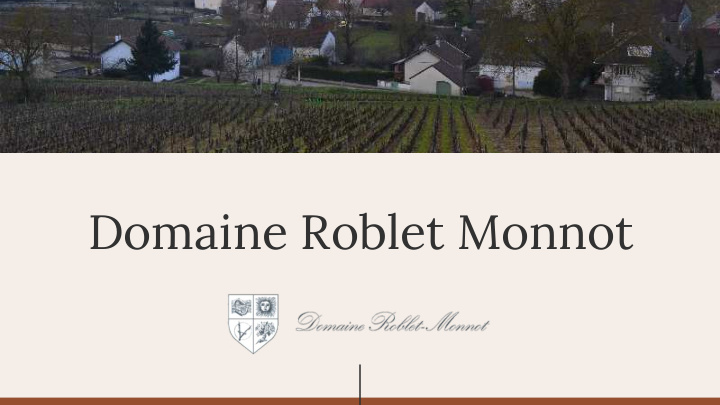



Domaine Roblet Monnot
The Profile ROBLET MONNOT is the domaine of Pascal Roblet who is the 14th generation of his family to earn his living as a vigneron (grape grower) in Volnay. He says that for all of his memory (and, to his knowledge, for long before he was born), his family has farmed using organic principles with no pesticides or weed killers or other chemicals. In 1997 he converted from organic farming to biodynamics and since then has been a strict follower of the lunar calendar, even holding up shipping a container soas to be able to bottle at the correct phase of the moon.
The vineyards are in and around the three contiguous Cote de Beaune The vineyards appellations of Pommard, Volnay, and Meursault. Roblet has been gradually replanting the domaine with most of his new planting at the very high density of 12,000 vine per hectare. In most of Burgundy, 5,000 vines per hectare is considered normal and 10,000 is considered high density. 12,000 is borderline fanatical. While all the vineyards (which are among the most pristine in Burgundy) are in Pommard, Volnay (mostly), and Meursault, the actual winery is across the highway (and across the tracks) in Bligny-les-Beaune. Roblet does most of his vineyard and winery work with the help of just one assistant although he does have to hire pickers at the harvest.
The very high quality fruit he grows is brought into the winery where it is processed into tanks for a 2-3 day, pre-fermentation maceration (cold soak). No stems are used except for the ripest vintages of from the Volnay-Piture vineyard. All the other plots are fully de- stemmed. The fermentations are in these same open top tanks, most of which are temperature controlled stainless steel with a couple of wooden (oak) tanks. Cap management is by pigeage (punching down) and the wines generally get a 2-3 day cold soak before the alcoholic fermentation is allowed to start. Fermentations start naturally with indigenous yeasts and malo-lactic fermentation (in barrels) occurs naturally using the native lacto-bacillus bacteria. The wines are aged in light toast, 30-month air-dried, all French oak barrels from one cooper (Chassin). The use of new barrels is carefully restrained to allow the purity and complexity of the fruit and the character of the sites to show through in the finished wines. The aged wines are racked only once about four weeks before bottling and that racking is from barrel to tank for the assemblage. This very protective, non-oxidative treatment is only possible because of the very high quality of the grapes produced by meticulous, very clean farming and the resulting healthy lees. The Wine Making
Pommard Arvelets 1er Cru Les Arvelets vineyard is centered on a steep south-facing slope at 886 feet of elevation northeast of highway D 17. It is surrounded by the vineyards La Chanière, Les Charmots and Clos de Verger.
Volnay Taillepieds 1er Cru VINEYARD Taillepieds is a 7.16 hectare (17.7 acre) vineyard on the southwestern side of Volnay. SOIL Small stones with clay and limestone mix VINE AGE 50% is 45 years old; 50% is 23 years old
Volnay Saint Francois 100% PINOT NOIR Village Wine but some juice is sourced from 1er Cru vineyards. St. François is a proprietary name. Pascal Roblet’s father was named François.
Volnay Brouillards 1er Cru 100% PINOT NOIR Brouillards originates from ancient French Breuil from Latin Brogilus from Gallic Brogilos “small territory” then “thicket wood, young wood”. At one time this land surely was wooded..
Volnay Santenots 1er Cru 100% PINOT NOIR The vineyards are actually located in Meursault but are entitled to be labeled Volnay Santenots due to their greater resemblance to Volnay reds. There are six climats: Les Plures or Les Petures, Les Santenots Blancs, Les Santenots du Milieu, Clos des Santenots and Les Santenots Dessous. Owing to more clay in the Les Santenots soil than much of Volnay, the wines exhibit ample body and sumptuous texture without associated tannins. Only Pinot Noir is planted.
St. Jean is a common term used for blends of Volnay Premier Cru wines. It refers to John the Baptist. This wine is generally a blend of Premier Cru Robardelle, Mitans and Pitures vineyards. In years where Pascal does not bottle Taillepieds, Santenots or Brouillards, grapes from those vineyards could be in this blend. Volnay Saint Jean 1er Cru
Recommend
More recommend